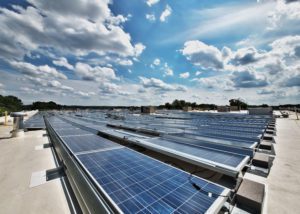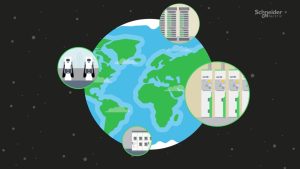Solar installations at commercial and industrial buildings have soared in recent years, with businesses realizing that they’re smart investments. Part of the reason is that solar installations produce clean, locally generated energy — a must-have in a time of ambitious sustainability goals.
But not all solar installations are alike. According to a 2021 study by Berkeley Lab, 98 percent of non-residential solar installations aren’t paired with a battery, meaning power doesn’t flow when the utility grid goes down.
Why don’t solar panels work during a power outage?
In this blog post, I explain the limitations of standalone solar and share technology available today that helps facility managers and building owners maximize the value of an installation.
Why solar panels don’t work during a power outage
Standalone grid-tied solar installations depend on the utility grid to provide a stable voltage and frequency reference. When the utility grid goes down, so does the solar installation, because the solar inverter that converts solar-generated D.C. into A.C. loses its reference point. The inverter also shuts off to better protect workers repairing the grid.
To continue generating power during a utility grid outage, solar installations require a local, independently functioning grid-forming resource.
How to use solar panels during an outage
Now that you know you need another resource instead of the grid to provide the voltage and frequency reference when the grid is down, you might be wondering how to add such a resource to your site. Unfortunately, it’s not quite as easy as just dropping off a battery.
Existing solar installations require a combination of electrical distribution equipment, controls, and battery energy storage to operate continuously and autonomously, whether the utility grid is up or down. Collectively, these solutions are called a microgrid.
The U.S. Department of Energy defines a microgrid as a group of interconnected loads and distributed energy resources (DERs) within clearly defined electrical boundaries that act as a single controllable entity for the grid. These self-contained electrical networks are designed to give you more control over how and when you use your power.
As explained above, each system features low- or medium-voltage electrical distribution equipment that ties in the solar, batteries, EV chargers, and other loads. When the microgrid includes a battery energy storage system, the solar will generate electricity even when the utility grid is down. The addition of software and controllers complete the solution by enabling the system to operate in grid-tied mode, or transition to island mode without any manual input. Because each campus or building’s energy needs and goals vary, microgrids are customized per site.
Are you getting the full value of your solar?
Solar is an important, strategic investment for many organizations. But it doesn’t provide the resilience essential in today’s challenging energy and weather landscape. What a microgrid does is help tap into the full value of that installation — so business owners and facility managers can ensure resilient power and meet other strategic goals.
Take battery energy storage systems: When you add this technology to your existing solar installation, you enable the solar to work when the grid goes down. But you can also engage the system while the grid is up and running to lower utility bills, feed new loads like EV chargers, and generate new revenue streams by participating in ancillary markets.
The Daughters of Mary of the Immaculate Conception in New Britain, CT, is a great example of an organization tapping into the full value of their solar. The campus had an existing solar system, but besides generating their own power, they wanted to use it as a backup source and reduce their carbon footprint. Microgrids were the ideal solution to turn these ambitions into a reality. The solution will produce approximately 545,000 kilowatt hours of additional solar energy and shrink greenhouse gas emissions by 1,300 metric tons.
So, how can a microgrid benefit your facility?
- Reliability: Ensure continuous operations, even when the grid goes down
- Emissions: Produce on-site renewable energy
- Cost: Reduce peak demand charges from the utility and help energy budgeting with predictable costs
- Sustainability: Meet government and organization-specific sustainability mandates
- Income: Generate supplemental income
Curious to see how a microgrid works? Follow this link to watch a video.
Is a microgrid right for you?
Now that you understand “why” a microgrid can help you get the most value out of your solar installation, you may be wondering “how.”
How do you determine if a microgrid is right for your existing building or campus? What does the design, implementation, and maintenance of the system entail if you have an existing solar installation?
We have the answers to these questions and more. Download this e-guide to learn how to get the full value from your solar-only system.



